


As previously described, forestry curriculum development (FCD) in Vietnam has changed from the linear expert approach to a PCD approach. Since 1994, the PCD process has been implemented with two main activities: developing specialization subjects and a social forestry major at the Forestry University, and developing common subjects for all of the five agriculture and forestry universities.
In 1996, when the PCD approach was first introduced with support from the Social Forestry Support Programme (SFSP), a stakeholder analysis was carried out.
The results of the analysis, showed that in order to develop a relevant curriculum to meet the development strategy of forestry sector, it is necessary to get the participation of different stakeholders in the process.
Forestry curriculum development in Vietnam needs the participation of many individuals and institutions from within as well as outside Vietnam. Though each stakeholder has its own interests, motivations and viewpoints in regard to curriculum development, a vision of the whole curriculum development process can be created through an examination of stakeholder functions, roles and influences.
The roles of stakeholders in curriculum development in Vietnam since 1994 are illustrated in the following Table:
Table 3: Stakeholders' roles in curriculum development
Stakeholders/Types |
Functions and Contributions | |
A |
Stakeholders in training institutions |
|
1 |
Curriculum developers |
Designing curriculum |
2 |
Teachers of subjects |
Participating in writing lectures |
3 |
University training managers |
Managing |
4 |
Students |
Evaluating training |
B |
Stakeholders outside training institutions |
|
5 |
Researchers |
Consulting the content |
6 |
Policy makers (Policy Officers of MOET and MARD) |
Participating in curriculum design |
7 |
Project managers (managers of rural development projects) |
Participating in training needs assessment |
8 |
Training managers at ministerial level |
Control |
9 |
Trainers at high schools and technical vocational schools |
Participating in training needs assessment |
10 |
Agricultural and forestry extensionists |
Participating in teaching material development |
11 |
International and non-governmental organizations in and outside Vietnam |
Consulting |
12 |
Sponsors |
Linking |
13 |
Farmers |
Providing information |
14 |
Graduates |
Evaluating training courses |
Many of the stakeholders listed above are potential employers of university graduates (universities, schools and training institutions, research institutions, projects, extension departments, INGOs and NGOs and state forest enterprises). A small number of university graduates may become farmers. To date, private business in the forestry sector has been slow to develop in Vietnam, and does not yet have a clear role in regard to forestry education. This situation may well change in the future, however, and it illustrates the need to constantly monitor the context of forestry education in order to identify the full range of potential stakeholders. A stakeholder participation matrix in Table 4 presents the range and type of stakeholder involvement (Taylor, 2000).
Table 4: Stakeholder participation matrix
TYPE OF PARTICIPATION | ||||
Stage in cycle |
Informed |
Consulted |
Partnership |
Control |
TNA/ situation analysis |
University authorities (Heads of faculty, Training Dept.); MARD; MOET. |
farmers; |
provincial extension; |
WPI core team members |
Aims |
MARD; MOET |
wide range of national, regional and international organizations; |
university authorities (Heads of faculty, Training Dept.); |
WPI core team members |
Planning |
MARD; MOET |
wide range of national, regional and international organizations; |
university authorities (Heads of faculty, Training Dept); |
WPI core team members |
Implementation |
MARD; MOET |
external consultants |
university authorities (Heads of faculty, Training Dept.); |
WPI core team members |
Evaluation |
MARD; MOET |
teachers in forestry faculties; |
Support Unit; SFSP |
WPI core team members |
For some time, there has been a considerable degree of participation in curriculum development between faculties of forestry in Vietnam. For new subjects, teachers develop draft curricula, then share them with a wide group of colleagues. Following comments and amendments, the curricula are presented to a higher level of authority within the faculty. The curriculum framework is then presented to the University authorities for approval before going to decision makers in the MOET for final approval. While this mechanism encourages the involvement of "insider" stakeholders, in the past it has been difficult to engage "outside" stakeholders in curriculum development with approaches other than consultation in a TNA.
In order to encourage greater stakeholder involvement, the SFSP supported a series of PCD awareness-raising workshops. The purpose was to invite key "inside" stakeholders such as staff and students from university faculties, departments and centres, as well as a range of key "outside" stakeholders. This latter group is often diverse, and its composition may vary depending on the context in which a particular university faculty is located. So far, representative stakeholders have come from provincial and district level government departments (forestry, agriculture, veterinary), research institutions, schools and mid-level training institutions, community organizations such as the women's union, and from various rural development projects.
One of these workshops used the current forestry curriculum as a starting point for discussion through a simple Strengths, Weaknesses, Opportunities, Threats (SWOT) analysis. Discussion focused on the tasks which forestry graduates are likely to carry out, and compared perceptions about the knowledge, skills and attitudes needed for forestry with what is covered by the current curriculum. Participants looked at the curriculum as an integral whole, thinking about issues such as the balance of technical versus social and economic subjects, and on ways to ensure that learners gain relevant, high quality and timely field experience.
Some clear recommendations emerged from this workshop, including the recommendation that the social component of the forestry should be developed and increased, due to a perception amongst participants that forestry extensionists lack a range of social knowledge, skills and attitudes, for example in communication, extension, facilitation and participatory approaches in general (Taylor, 1999).
Another method to involve external stakeholders includes inviting both outside and inside stakeholders to review meetings at which curriculum development progress reports are presented, as well as to training events where draft curricula are prepared. Stakeholders representing groups targeted for training are then in a position to give direct inputs into the curriculum planning process, with advice on effective timing and location of training, potential participants. Stakeholders may also then be in a position to influence the aims, objectives and content of training programmes.
Additionally, the TNA Survey on Social Forestry (Helvetas, 1996), conducted in ten provinces in the three main regions of Vietnam. The survey was part of a process aimed at improving the training and educational support system for people working with social forestry in Vietnam. Stakeholders participated in the process from the first steps of investigation on task analysis, to the stage of information analysis and synthesis in order to probe for gaps in knowledge, skills and attitudes.
The National Workshop on Social Forestry Training Needs, held in November 1996, analysed these survey results and proposed appropriate forms of training (needs for new subjects, major and short courses), suggested ideas for training course design, and even provided outlines for some curricula. Another output of the Workshop was a series of proposals for ways to strengthen co-operation between institutions in curriculum development.
A description of the process, from the TNA up to the convening of the National Forestry Workshop on Social Forestry Training, is illustrated in figure 8. This important Workshop was organized jointly by Xuan Mai Forestry University and the Helvetas Social Forestry Support Programme. A wide range of stakeholders participated, including teachers from all universities involved in forestry education programmes, policy makers, project managers and researchers.
The main outcomes of the workshop, based on the findings of the TNA, were as follows:
Based on the workshop outcomes, working teams, with the participation of teachers from different universities developed curriculum frameworks including subject name, justification, objectives, and topic arrangement. They then went on to develop detailed content, time, teaching methods and teaching materials. Arrangements for practice and a practicum for each subject or of the whole training course were also defined.
Researchers, project managers and policy makers were mobilized to participate in teaching or experience exchange in certain topics for these courses. Subject groups were formed which then carried out specific TNAs. Stakeholders were invited to comment, either in a written format or through small workshops, on the draft curriculum frameworks and the detailed content. Some stakeholders with particular expertise were invited to give guest lectures to students.
One of the spin-offs of this process was the opportunity for personnel from the Universities to interact and to share professional experiences. This accelerated process of interaction was important for strengthening of the emerging social forestry network, made up from these five universities. This information exchange network has also created favourable conditions for information exchange and sharing with other organizations from within, as well as from outside Vietnam.
A range of stakeholders including project managers, university-graduated staff, farmers and agricultural and forestry extensionists also participated in evaluating specific subjects and the training courses. By the end of each course, students and trainees were asked to evaluate the objectives, content and teaching methods. The evaluation results are very useful for the improvement of the subject curriculum, and show the importance of various stakeholders as important sources of feedback. The evaluation process was based on the Context-Input-Process-Product (CIPP) model. Although the evaluations identified many strengths of the forestry education programmes, there were some areas were improvement was necessary.
A training-research-forestry extension network was established in 1998 with participation of Xuan Mai Forestry University via the Social Forestry Training Centre, the National Institute of Soil and Fertilizer and Hoa Binh Agricultural and Forestry Extension Centre. These three institutions co-operated in three hamlets of Hoa Binh Province on participatory technological development, farmer training, material compilation, documentation and information sharing. It was the first time there had been co-operation between the institutions. The research results in forestry extension were compiled in the training curriculum and the main findings were:
Recently, many international organizations (SIDA, Rural Development Projects of EU, GTZ, CARE, IFAD) and non-governmental organizations, have shown their concern for human resource training and development through agricultural and forestry development projects. Members of the Social Forestry Training Network have been contracted to provide training and inputs on rural appraisal, human resource training and technological development, among others. This has helped link outside organizations with the training activities of the universities.
Additionally, participation of stakeholders has been greatly encouraged as a result of the information exchange between organizations, the publication of magazines and newsletters about social forestry, and with the participation of overseas organizations such as RECOFTC, IIRR, and networks such as the SE Asia Network on Agroforestry Education (SEANAFE).
Table 5 shows a series of activities involving stakeholder participation between 1994 and 2000.
Table 5: Activities involving participation of different stakeholders in forestry curriculum development in Vietnam.
Time |
Issues |
Stakeholders |
1995-1998 |
Training in PCD, research and forestry extension. |
Teachers of five agricultural and forestry universities. |
Sept - Oct, 1996 |
National training needs survey. |
Teachers of five universities; |
Nov. 1996 |
National Workshop on social forestry training. |
Approximately 100 participants from training and research institutions, projects in and outside Vietnam. |
Nov. 1996 |
Establishment of working teams for social forestry curriculum development. |
Teachers from universities; |
1997-1998 |
Evaluation of two social forestry specializations in Xuan Mai. |
Teachers; |
1998 |
Regional training needs assessment. |
Stakeholders in training needs assessment. |
1998 |
Completion of social forestry curriculum framework in Xuan Mai. |
Teachers; |
1998 |
Workshop on combination of training with research and forestry extension in Xuan Mai. |
Trainers; |
1999 |
Agreement of curriculum framework of four subjects in SFSP. |
Teachers from five universities. |
1999 |
Workshop on PCD of SFSP in Hanoi. |
Representatives from training and research institutions; projects and NGO organizations. |
1999 |
Development of a common curriculum of four subjects. |
Teachers of five universities; |
There have been different approaches to curriculum development between the universities because of the different types of courses being developed. At the Forestry University of Vietnam, curriculum development has focused on the development of social forestry specialization subjects and a major in Social Forestry. For the other four universities offering forestry degree programmes, curriculum reform has been centred on the forestry degree itself, and in particular on the revision of key subjects. Since the processes in these cases vary, they will be presented here as two separate examples of the PCD process in Vietnam.
Stakeholder Analysis
The first stage of PCD in this setting was a strengths, weaknesses, opportunities, and threats (SWOT) analysis of the current curriculum development process in place at the Forestry University. This was followed by a stakeholder analysis for three types of courses: short courses, an introductory social forestry subject and for the B.Sc. forestry degree programme. A list of stakeholders was generated, followed by the identification of their interests in the curriculum development process and the potential impact of change based on their interests. Tables 6 and 7 show the results of this exercise for the B.Sc. degree programme, for both "outsiders" and "insiders''.
Table 6: Degree programme - "outsider" stakeholders
STAKEHOLDER |
INTERESTS |
IMPACT OF CHANGE ON INTERESTS |
MINISTRY OF EDUCATION AND TRAINING |
JOBS, PROFESSIONAL DIVERSITY |
+ |
MINISTRY OF AGRICULTURE AND RURAL DEVELOPMENT |
DEVELOP HUMAN RESOURCE |
+ |
ETHNIC MINORITY AND MOUNTAINOUS COMMITTEE |
FIXED CULTIVATION, SEDENTARIZATION |
+ |
UNIVERSITY NETWORK |
EXCHANGE INFORMATION |
+/- |
Table 7: Degree programme - "insider" stakeholders
STAKEHOLDER |
INTERESTS |
IMPACT OF CHANGE ON INTERESTS |
MANAGERS |
DIVERSIFY AND OPEN UP TRAINING |
+ |
TEACHERS |
RAISE STANDARD AND INTERNATIONAL CO-OPERATION CAPACITY |
+ |
STUDENTS |
APPROACH TO NEW KNOWLEDGE |
+ |
FACULTIES, DEPARTMENTS |
ORGANIZATIONS ARE OPENED AND DEVELOPED |
+ |
Following this initial listing of stakeholders, an "importance" & "influence" matrix was created, as described earlier. This showed the relative importance of each stakeholder and their potential influence in the process.
Figure 7: An "importance" & "influence" matrix
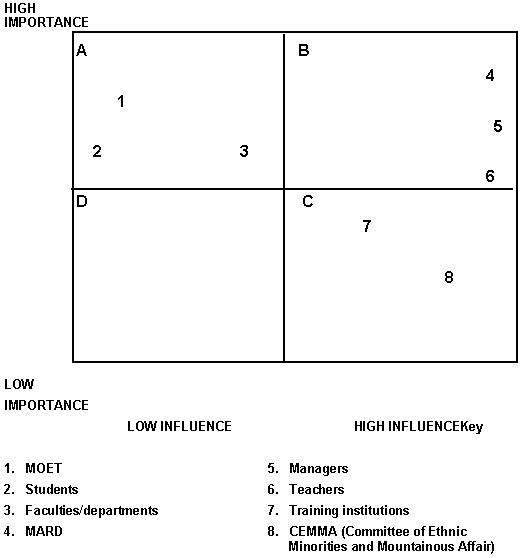
Finally, this information was used to develop a participation matrix (Table 8) for the development of a forestry degree programme in relation to the PCD cycle presented earlier in this paper.
Table 8: Participation matrix showing roles of stakeholders in the PCD process
Type of participation Stage in cycle |
INFORM |
CONSULT |
PARTNERSHIP |
CONTROL |
TNA |
Managers; |
MARD; |
Teachers; |
Funders; |
AIMS |
Production units; |
MARD; |
Teachers; |
MARD; |
PLANNING |
Teachers; |
Training managers; |
Teachers; |
Funders |
IMPLEMENTATION |
Teachers; |
Teachers; |
Teachers; |
Training managers; |
EVALUATION |
Teachers, |
Teachers; |
Teachers; |
Funders; |
The results of the stakeholder analysis helped the team at the Forestry University to plan the following national training needs assessment and National Workshop on Social Forestry Training. The analysis provided guidance about how the various stakeholders could become involved throughout process, and made planning more open and transparent. While these events have already been discussed, it is worth highlighting a few relevant points.
A summary diagram of the steps leading from the TNA survey to the National Training Needs Workshop is presented in Figure 8.
Figure 8 Steps leading from the TNA survey to the National Training Needs Workshop (Paul, 1997)
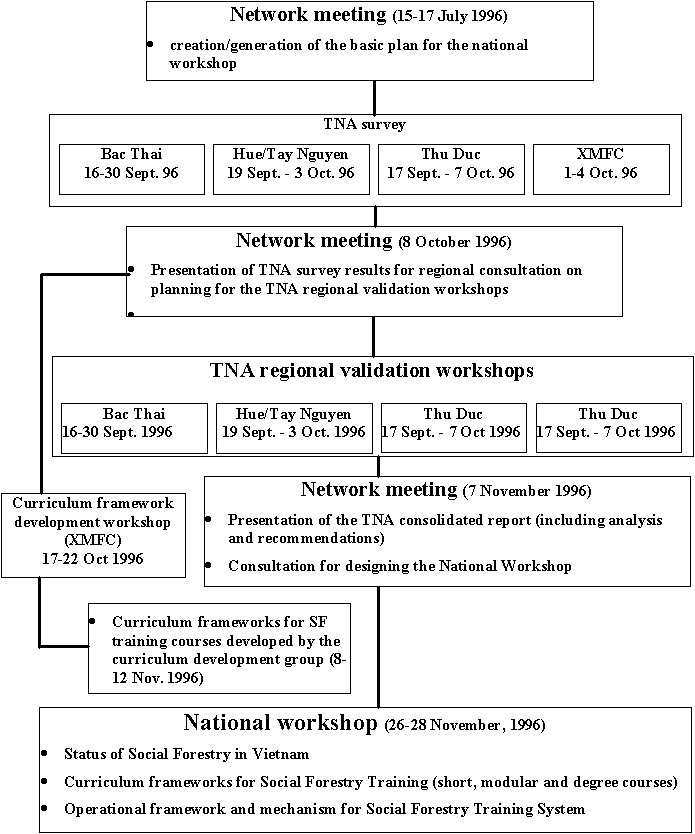
The main purpose of the TNA survey in 1996 was to find out:
This basic set of information was collected directly from the informants. Details of the latter are presented below in Table 9.
Table 9: Numbers of informants working for different organizations
South |
Central |
North |
Hanoi |
Total | |
Agriculture and Rural Development |
14 |
7 |
4 |
- |
25 |
Extension |
3 |
2 |
7 |
- |
12 |
Forest Enterprise |
13 |
7 |
2 |
- |
22 |
Forest Protection |
6 |
3 |
3 |
2 |
14 |
Management Board |
3 |
- |
- |
- |
3 |
Research |
3 |
2 |
2 |
1 |
8 |
Peoples Committee |
1 |
- |
1 |
- |
2 |
Development Board |
2 |
- |
- |
- |
2 |
Resettlement |
1 |
- |
- |
- |
1 |
Mass Organization |
- |
1 |
- |
3 |
4 |
Non-Government Organization |
- |
- |
- |
1 |
1 |
Bilateral |
- |
- |
- |
1 |
1 |
Ministry |
- |
- |
- |
11 |
11 |
University |
- |
- |
2 |
- |
2 |
School |
46 |
24 |
23 |
24 |
117 |
Following the needs assessment, work began on developing a social forestry specialization and social forestry major at the Forestry University. This work involved a range of stakeholders as described in the previous section, who contributed their ideas through surveys, commented on curriculum frameworks, content and learning materials, and in some cases, presented guest lectures. In addition, an analysis of existing curricula was carried out. To illustrate the situation pertaining in 1996, the forester training process at the Forestry University is described in the curriculum tree shown in Figure 9.
Figure 9: Curriculum tree for forester training at the Forestry University of Vietnam
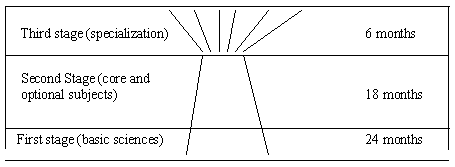
The degree programme consists of three consecutive stages. All students must complete all stages in order to receive a degree. There is no intermediate diploma award and all students must enter at the first stage, irrespective of experience.
The purpose of the first stage is to train students at the university level in basic sciences such as mathematics, physics, chemistry, biology, informatics as well as foreign languages, basic economic and social knowledge and physical training. The curriculum of these subjects has been in existence for quite some time, and has not changed since it was developed by the MOET. Training institutions, for their part, have little opportunity to change this curriculum.
The purpose of the second stage is to train students in basic subjects and specialized forestry subjects. This stage can be divided into four subject groups:
The third stage is to provide students with a specialization which students can choose themselves. Upon completion, students will undertake their practical training, and write a graduation thesis.
Since the first stage of study is not easy to change, curriculum development and revision concentrated mainly on the second and third stages. After the National Workshop on Social Forestry Training Needs, five curriculum development-working groups were established to analyse the workshop results, study-training experiences from other countries, and work with experts from foreign countries. These working groups developed curriculum frameworks, detailed content and teaching materials, and identified more appropriate teaching methods.
The process in which these groups were involved is presented in Figure 10, and the outcomes of their work are presented in Figure 11 and Figure12.
Figure 10: Curriculum development process after the National Training Needs Workshop
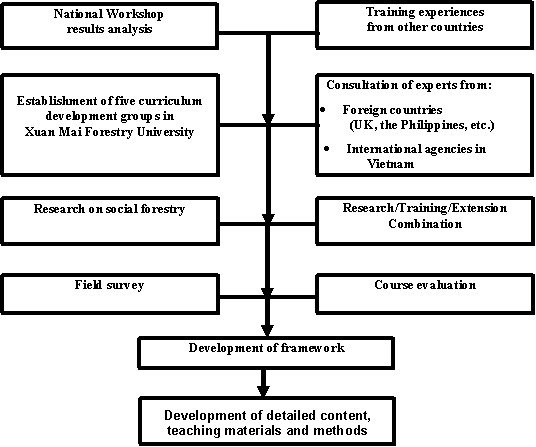
A strong understanding had been reached about what the new social forestry specialization and major should look like (Figures 11, 12 and Table 10). Interdisciplinarity was a key element. To achieve this, stakeholders were invited to participate in setting strategies and designing curricula in addition to compiling teaching materials. In the National Social Forestry TNA, participants in interviews and training needs analysis were from different sectors, fields and development projects. Objective-setting for each training course or subject was based on the analysis for gaps in knowledge, skills and attitudes amongst current forestry workers. Course objectives, content, methods and suitable teaching materials were identified based on requirements and feedback of the stakeholders.
As a result of the extensive input from stakeholders from different sectors, the Forestry University team felt that they had succeeded in developing an interdisciplinary curriculum. The structure of the social forestry specialization programme which was developed is illustrated in Figure 11, whilst Figure 12 provides a detailed structure for the social forestry major, indicating the main subject groups. The percentages allocated to content of each component of the theory in the major were debated during a workshop. The basis for the discussion was the concept of the "future forester" (Figure 3). The content of the major is presented in Table 10.
Figure 11: Course structure of Social Forestry specialization showing the extent of interdisciplinarity.
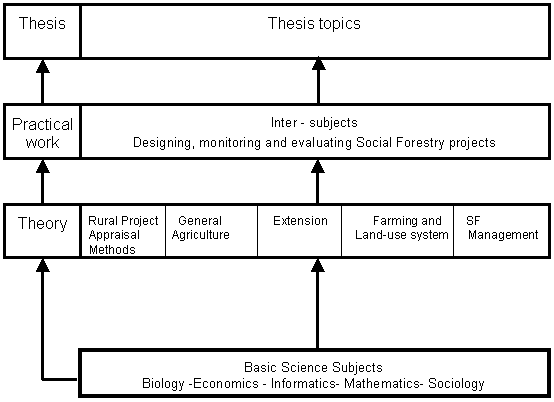
Figure 12: Course structure of Social Forestry major, showing categories of subjects
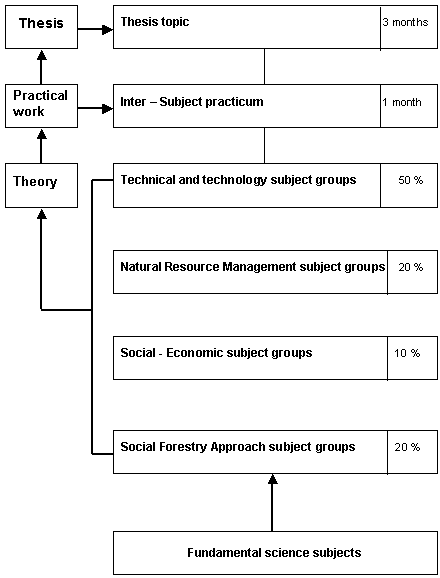
Table 10: Subjects in the Social Forestry Major, Xuan Mai Forestry University
Types of training |
Introduced subjects |
Time of training |
Number of students |
1. Introductory social forestry |
45 periods, introduced since1993 up to now |
500-600 students per year | |
2. Social forestry specialization |
First training |
First training course: 20 Students | |
3. Social forestry major |
First training course started in 1998 |
1997: 60 Students | |
3.1. Technique and technology subjects group |
|||
3.2. Natural resource management subjects group |
|||
3.3. Socio-economic subjects group |
|||
3.4. Social forestry approach subjects group |
The social forestry specialization training was implemented at the Xuan Mai Forestry University in 1997 and 1998, whilst the social forestry major started in 1998. Table 10 shows the subjects introduced, the time of training and number of students for the major.
Curriculum evaluation has been implemented at three levels: evaluation of each subject, evaluation of the specialization training courses and evaluation of the major.
An evaluation of each subject is undertaken after the subject finishes. Evaluations are based on the curriculum framework for each subject, the course objectives and content for each topic including time, methods and relevant teaching materials. The curriculum framework for the course is sent to the students who can then compare the framework with the teaching methods, and provide feedback in their evaluations.
Evaluation of training courses is based partly on the comparison of the designed curriculum of training courses with activities implemented. Evaluation of training courses has had the wide participation of teachers, training managers, agricultural and forestry extensionists, students, and many others. The evaluation of the social forestry training course was combined with a further evaluation of training needs through a series of surveys on the following topics:
In June 1998, an evaluation of the social forestry specialization course was conducted with the participation of different stakeholders in and outside the social forestry training centre of the Forestry University. The purpose of this evaluation was to find ways to improve the course. The methods of evaluation were based on a participatory methodology, using the context, input, process, and product (CIPP) model. The evaluation focused on new factors influencing social forestry training, the developing political and socio-economic context in Vietnam, and new types of management in the forestry sector in Vietnam. The input evaluation focused on the quality and quantity of students and lectures as well as teaching and learning conditions. The process evaluation focused on the teaching and learning process and on the monitoring and evaluation process. Product evaluation focused on the quality of course graduate. The evaluation revealed that still more improvements were needed, with a number of shortcomings becoming apparent. These are noted in Table 11.
Table 11: Main shortcomings of the forestry programme and Social Forestry specialization course
Content |
Main shortcomings | |
1 |
Subject group of techniques and technologies |
|
2 |
Subject group of natural resource management |
|
3 |
Subject group of socio-economics |
|
4 |
Subject group of approach and facilitation |
|
5 |
Subject group of specialization |
|
6 |
Practice and writing graduation theses |
|
7 |
General evaluation |
Following the evaluation, it was decided to integrate the specialization subjects within the new social forestry major, so there would no longer be a social forestry specialization. The specialization was now no longer needed, since the subjects included were now to be subsumed within the new major. Developing the major at the Forestry University is a very large exercise, but by the beginning of 2000, the subject frameworks and some detailed content, learning methods and materials had been completed. This work is ongoing, and continues to depend upon wide stakeholder involvement.
Stakeholder analysis and training needs assessment
Curriculum development at the Vietnam Forestry University had centred around the development of a social forestry major. In the other forestry faculties, the effort has been made to introduce a socio-economic orientation within the B.Sc. forestry degree programme. As it was not clear how this should be undertaken, especially in the context of the rapid changes in land use and management in upland areas of Vietnam, a major information gathering exercise was initiated. In 1998, a series of regional training needs assessments were organized in five different areas of Vietnam and implemented by four forestry faculties and the Hoa Binh Agriculture-Forestry Extension Centre. The objectives of the TNA were:
A stakeholder analysis was undertaken to guide the TNA exercise and subsequent curriculum development activities. A wide range of stakeholders were identified, including government and non-governmental organizations from the forestry sector as well as others from the non-forestry sectors.
While villagers' livelihoods have significant impact on national and regional development, in the present structure, decision making roles are not in the hands of community or households, but rather at national and regional levels in public and private sectors. The TNA team first tried to understand institutional activities related to the relationships local communities have with forest resources. It was hoped that this approach could bring a common understanding of what is meant by social forestry in Vietnam and how universities could contribute heavily and effectively in developing social forestry as an approach for sustainable development. Villagers in local communities are considered a valuable source of information as they have accumulated knowledge about people's life, needs and stakeholders' activities when implementing social forestry practices. It was therefore expected that they could offer feedback about outsiders' current knowledge, skills and attitudes on communities' needs related to social forestry.
In general, results from the TNA point out the recurring demand to include the human dimension - the social, cultural and management aspects - into forestry training without necessarily de-emphasizing the technical and scientific dimensions. Recognizing this, the TNA results may be broadly read as suggesting the development of personnel capacities in these three main areas:
The TNA results indicate the need to develop extension and training capacities in social forestry with an emphasis on participatory learning methodologies. For the field personnel, this means being able to engage in action-based learning activities not only with the communities they work with but also with other communities and with the office/research support system. For the education personnel, this means being able to complement and relate their theoretical constructs with field-based realities and practices. And for the office personnel, they can better support field-based social forestry projects if they develop a general understanding of participatory learning concepts in relation to people and communities that their projects work with.
By enhancing capacities related to participatory learning methodologies, the social forestry professional at the same time strengthens his/her skills and/or knowledge of field-based social forestry research. Some specific research skills which need to be developed, as expressed in the TNA results, are: documentation and communication skills for the field personnel; skills related to participatory technology development for the education/research personnel and; participatory evaluation methods for the office personnel.
Participatory management capacities
Project management often tends to be associated mostly as a function of the office (administration and management) personnel. However, recognizing that field and education/research staff do not merely implement projects but also have to manage activities at the field level, many of the TNA informants have expressed their desire to at least better understand project management concepts and practices. Project management has a series of interrelated activities ranging from design and planning to implementation, monitoring and evaluation. It also includes project documentation and reporting. In broad terms, this implies designing training courses related to: managing community-centred extension projects for field personnel; managing participatory and action research projects for education/research personnel; and managing social forestry projects/programmes in general, for office personnel.
Networking arrangements in support of social forestry training
A further examination of the TNA results also suggest that not all the required capacities (skills and knowledge) will have to be addressed through training courses. Some of them may be better responded to through other means which will have to complement and support the pre- and post-training activities. One such mechanism is by establishing network arrangements initially within and among the different TNA informant categories. The SFSP has already moved in this direction through its initiatives in establishing a network amongst the participating forestry faculties in the country. From the evidence collected, it was decided to focus subsequent curriculum development mainly in the areas of general social forestry, forestry extension, and project management.
The curriculum development process
Following the TNA exercises, curriculum development started at each university in earnest, offering the forestry degree programme. Between 1998 - 1999, it was observed that there was a tendency for each university faculty to develop its own curriculum and teaching materials, even in basic subjects such as "Introductory Social Forestry". The Social Forestry Support Programme decided to promote a greater degree of collaboration between universities, both in learning about PCD and in applying what had been learned through joint production of educational products (curriculum frameworks, learning materials and detailed content). There were several reasons for this. Firstly, it was clear that many of the concepts and principles were so fundamental that they should be included in the curriculum of each university. Secondly, collaboration could provide an opportunity for stakeholder views and inputs gathered by each working partners institution (WPI) through TNAs, field research, workshops and other events to feed into the overall curriculum development process. Thirdly, as a response to the scarcity of experienced social forestry teachers in some universities, collaboration would enhance the sharing of critical human resources.
After an initial agreement on the principle of collaboration, existing teaching materials were exchanged, and curriculum frameworks for three subjects were jointly developed, including Introductory Social Forestry, Forestry Extension, and Social Forestry Project Management. A fourth framework was also developed by members of the regional South East Asia Network for Agroforestry Education (SEANAFE). Three subjects groups, each of which included participants from all seven members of the Social Forestry Training Network communicated through e-mail and occasional meetings. Each working group agreed to prepare a common framework for their subject, with each university having the opportunity to add locally relevant topics or materials to the common part. The development of the framework was informed by different types of information and experience, which meant that the views and reality of a wide range of stakeholders were reflected.
A key workshop was organized and a wide range of stakeholders were invited, including personnel from national, regional and international forestry-related organizations, institutions and programmes. This workshop had two main objectives: to provide an opportunity for external stakeholders to give comments and feedback on the draft curricula presented at the workshop, and; to encourage linkages and networking between a wide range of groups and individuals with an interest in social forestry education and training. The ideas and opinions expressed have already informed the development of subject curricula, and new linkages between different organizations and programmes have been fostered (SFSP 1999).
It was well accepted by all participants that the curricula were not finished products, and they should continue to be developed in a dynamic way. The subject groups agreed to meet again after some months of internal discussions to finalize the frameworks, and to further develop curriculum content, methods and materials for teaching and learning. By the end of 1999, the subject groups had developed detailed curriculum frameworks, and had met again on several occasions to collaborate further. Exchange of information by e-mail also began to increase, reducing the number of personal meetings. Three subject groups have produced detailed curricula which include the following:
Each participating university has received a full set of these items, and teaching of some subjects has now commenced. An important task will be to evaluate, and subsequently review these new subjects to ensure that the curriculum development process remains dynamic and continuous.
For illustrative purposes, Figure 13 provides a diagrammatic presentation of the PCD process for four social forestry subjects within the forestry degree programme. Afterwards, a detailed outline of one of these subjects is presented.
Figure 13: PCD process for four Social Forestry subject groups
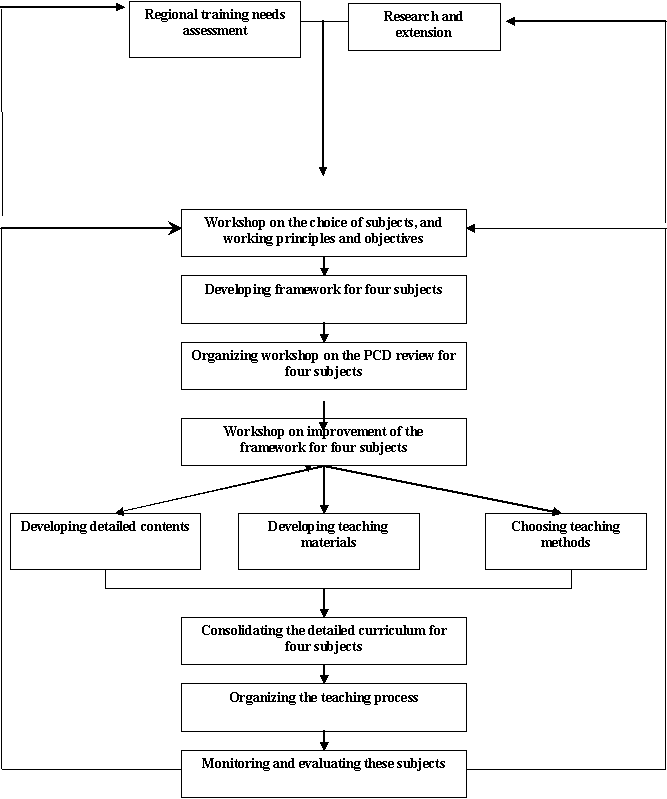
Planning the structure of each subject curriculum
The curriculum framework for each subject is based on the surveyed results about training demand, an examination of the relationship with other subjects, and the agreement of all the concerned institutions. It is perhaps useful here to provide an example of one of the subjects developed using this collaborative approach - introductory social forestry. The framework for this subject is presented below.
Table 12: Curriculum framework content for the Introductory Social Forestry subject
Topics |
Objectives |
Contents |
1. Overview of social forestry |
||
2. Policies related to the development of SF |
||
3. Human ecology in SF |
||
4. Participatory approaches |
Development of the detailed content, methods and materials for these subjects is continuing, also through collaboration. Implementation of these new subjects will take place towards the end of 2000, after which time an evaluation will be carried out with involvement of a range of key stakeholders. Although work is still underway, the content and materials developed so far seem to indicate that the quality of teaching and learning will be improved as a result of this collaborative effort.
Part IV described the roles and mechanisms used to encourage participation and feedback from various stakeholders in social forestry education in Vietnam. Two main processes of PCD have been analysed. The first process is the PCD for a social forestry specialization and the social forestry major at the Forestry University of Vietnam. The second process is the curriculum development for four common subjects for five agriculture and forestry universities. Part V now highlights some of the important lessons learned from these experiences, and also makes some recommendations.